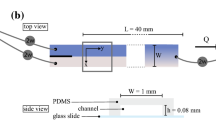Abstract.
A technique is proposed for the processing of digital particle image velocimetry (PIV) images, in one single step providing direct estimates of fluid velocity, out-of-plane vorticity and in-plane shear rate tensor. The method is based on a generalization of the standard PIV cross-correlation technique and substitutes the usual discrete cross-correlation of image pairs with a correlation of interpolated two-dimensional image intensity functions, being subject to affine transformations. The correlation is implemented by using collocation points, on which image intensity values are interpolated. The resulting six-dimensional correlation function is maximized using a general purpose optimization algorithm. The use of the method is demonstrated by application to different types of synthetically generated image pairs constructed with known particle displacement functions. The resulting errors are assessed and compared with those of a representative standard PIV method as well as with those of the present technique using no differential quantities in the search of the peak location. The examples demonstrate that significant improvements in accuracy can be obtained for flow fields with regions containing strong velocity gradients.
Similar content being viewed by others
Author information
Authors and Affiliations
Additional information
Electronic Publication
Rights and permissions
About this article
Cite this article
Mayer, .S. A generalized processing technique in digital particle image velocimetry with direct estimation of velocity gradients. Exp Fluids 33, 443–457 (2002). https://doi.org/10.1007/s00348-002-0474-z
Received:
Accepted:
Issue Date:
DOI: https://doi.org/10.1007/s00348-002-0474-z




